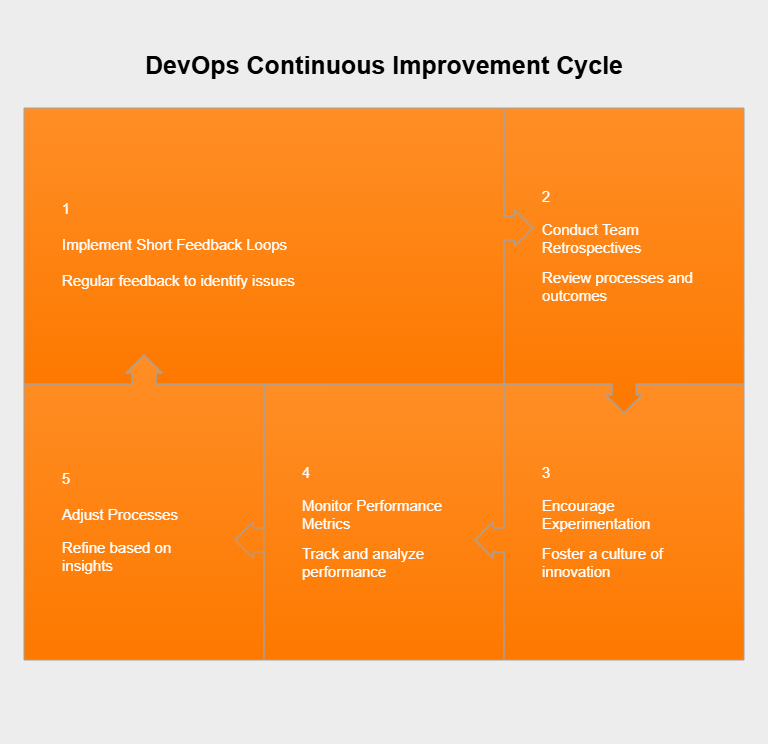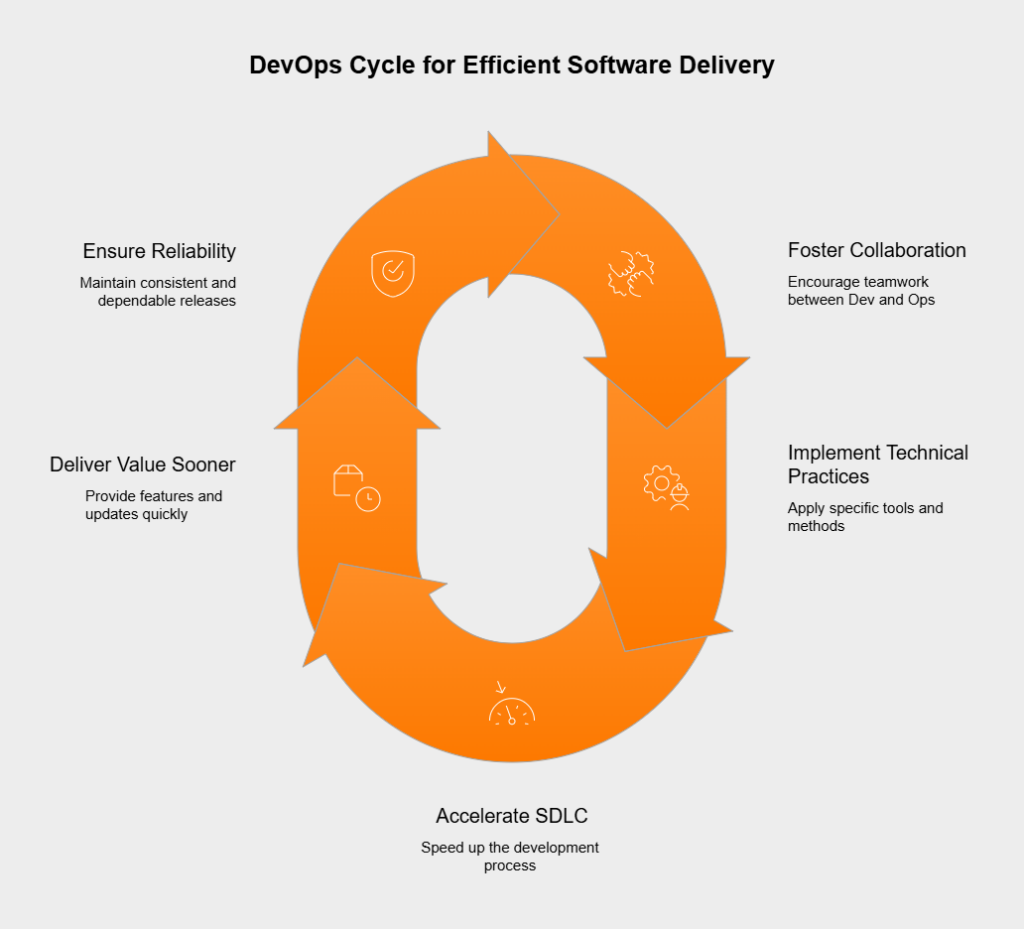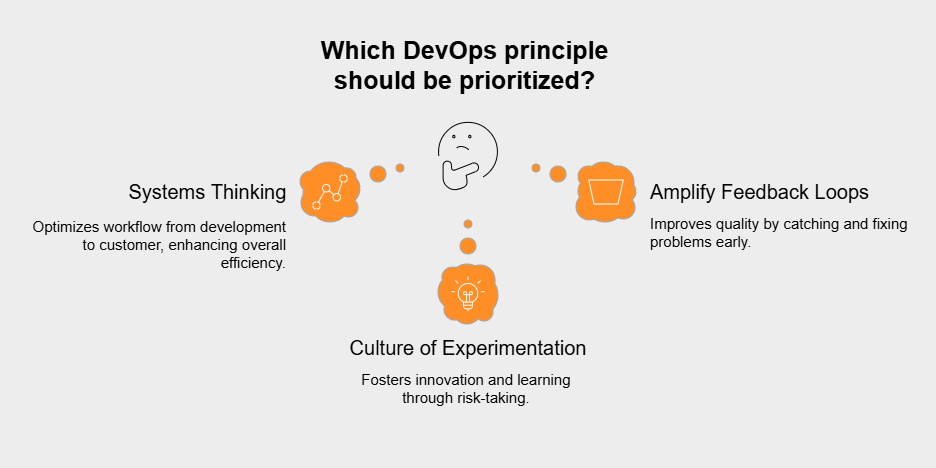11 DevOps Maturity Assessment Questions to Ask During the Audit
- April 02
- 6 min

What are key DevOps principles? At its heart, the DevOps philosophy works to close the long-standing divide between software development (Dev) teams and IT operations (Ops) teams. It’s really about a change in culture, backed by specific technical practices, all designed to speed up the systems development life cycle (SDLC). The goal? Get features, fixes, and updates out the door quickly and dependably. It boils down to fostering teamwork so that building, testing, and releasing software becomes a faster, more frequent, and reliable process, getting value to users sooner. This means shifting away from separate, walled-off duties towards everyone sharing ownership and making the whole software delivery pipeline smoother.

DevOps collaboration tears down the old walls separating development, operations, quality assurance (QA), and security. Rather than working in isolation, these different roles come together in cross-functional teams that share the same goals and responsibilities.
This relies on open communication, sharing what you know, and respecting each other’s contributions. Things like daily stand-ups, shared dashboards showing progress, and tools that work together help keep everything transparent. This way, everyone stays focused on shared targets like making sure the application runs well, stays stable, and keeps users happy. Getting rid of these silos cuts down on the delays, confusion, and competing agendas that often plague older ways of delivering software.
Automation is absolutely key to DevOps because it gets rid of tedious manual work, cuts down on mistakes people might make, and makes software delivery faster and more consistent. The whole idea behind DevOps is to automate pretty much everything you can in the SDLC – think code integration, testing, deployment, even managing the infrastructure. When you automate these steps, teams work more efficiently, get feedback quicker, and release software more reliably. Plus, it lets developers and ops folks concentrate on more important things like coming up with new ideas and making improvements, instead of being stuck doing the same routine tasks over and over.
Continuous Integration (CI) is all about developers merging their code changes into one central place often. Right after they merge, automated processes kick off to build the software and run tests, catching integration problems early on. Then there’s Continuous Delivery (CD), which takes CI a step further by automatically getting the tested and approved code ready for release, maybe to a staging area or repository. Some teams even use Continuous Deployment, which automatically pushes every good change straight into production. Put together, CI and CD create automated pipelines ensuring that every code change is reliably built, tested, and deployed, making frequent software updates possible.
Infrastructure as Code (IaC) fuels automation by letting you manage and set up your computing infrastructure—like networks, virtual machines, and load balancers—using definition files that computers can read. Instead of manually configuring hardware or clicking through setup tools, you write code. This means you can handle your infrastructure just like software: track changes with version control, test it, and repeat setups reliably. IaC makes automation easier because teams can quickly spin up, change, or remove environments using code. This guarantees things look the same in development, testing, and production, and it’s great for automatically scaling up or deploying new versions.
DevOps thrives on a cycle of continuous improvement and learning, drawing inspiration from Lean and Agile ideas about getting better step-by-step. It’s about always looking for ways to make processes smoother, cut out waste like pointless delays or manual tasks, and improve the final product. How does this happen? Through short feedback loops, regular team reviews (retrospectives), and building a culture where trying new things is encouraged and mistakes are seen as chances to learn. Teams keep an eye on performance metrics, figure out what worked and what didn’t, and adjust how they do things. This pushes innovation forward and makes the whole delivery pipeline progressively faster and more reliable over time.

Keeping a customer-centric focus in DevOps means putting the user first – getting valuable updates to them quickly and using their feedback to shape what comes next. Thanks to automation and teamwork, release cycles are short, so new features and fixes reach users faster. By constantly monitoring how the software is used and gathering feedback, teams understand how people actually interact with the product and what problems they run into. This direct user feedback guides the next round of development, making sure the product grows based on real customer needs, not just guesswork.
End-to-end responsibility means DevOps teams truly own the application for its entire life, covering everything from the first design sketches and coding all the way through testing, deployment, running it live, and keeping it maintained. This is quite different from older ways where work was just passed along between separate teams – like Dev writing code, then Ops taking over to deploy and manage it. When a team has end-to-end responsibility, the people who build the software are also on the hook for how well it performs and how reliable it is once it’s live. This naturally leads to more accountability, pushes teams to build software that’s easier to operate and more robust, and makes fixing problems much quicker when they pop up.
Security isn’t an afterthought in DevOps; it’s woven right into the lifecycle through an approach commonly known as DevSecOps. Rather than being a final hurdle just before release, security becomes part of the process from the very start and continues all the way through – often called “shifting left”. This means thinking about security during design, running automated security checks (like code analysis and vulnerability scanning) as part of the regular CI/CD pipeline, regularly looking for weaknesses, and automating checks for compliance rules. Building security in like this helps catch and fix vulnerabilities early, which cuts down on risks and avoids expensive repairs down the line. It makes security everyone’s job on the team.
In DevOps, monitoring, observability, and feedback are crucial for keeping systems healthy, reliable, and constantly improving. Continuous monitoring means gathering data like metrics and logs from applications and infrastructure to keep an eye on performance and spot problems before they escalate. Observability takes it a step further, giving teams the power to explore and ask specific questions about what’s happening inside the system, even if they didn’t plan for those questions beforehand. All this data acts as vital feedback, showing how changes affect things and what the user experience is really like. Teams rely on this info to quickly find and fix issues, grasp how their systems behave, make smart choices about what to build next, and keep their services stable and performing well.
Gene Kim’s “Three Ways” offer a useful framework for understanding the key ideas behind DevOps:
Together, these three ways provide solid guidance for putting DevOps culture and practices into action.

Putting DevOps principles into practice brings real, noticeable benefits to how software is delivered and how operations run. Typically, you’ll see faster time-to-market for new features and updates, mainly because workflows are smoother and automation handles repetitive tasks. Companies usually find they can deploy new versions much more often (increased deployment frequency) and have fewer problems with those releases, thanks to automated testing and solid CI/CD pipelines. Better teamwork and shared ownership also lead to higher quality, more stable software. Plus, all that automation and optimization makes operations more efficient (enhanced operational efficiency) and often cuts costs. The bottom line? Happier customers, IT that better supports business goals, and a clear edge over the competition. Start your better DevOps journey today, get in touch!
